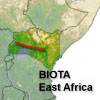 



Weather data
A large number of automatic weather stations has been implemented in the frame of the BIOTA AFRICA project by the Namibian National Botanical Research Institute (NBRI) and the Group "Biodiversity, Evolution and Ecology" (BEE) of the University of Hamburg. The website offers hourly updates of data and graphs of a large number of weather parameters.

|
 BIOTA East Africa - Workpackage(s)
BIOTA East Africa - Workpackage(s)
Subproject |
E03 - Regeneration of tropical trees - implications for forest conservation |
Workpackage |
WP4: Modelling of tree stand and forest growth |
Project leader(s) |
Dipl.-Biol Henning Todt
PD Dr. Andreas Huth |
Project description |
A large number of forest growth models have been developed for boreal and temperate forests, but only a small number for tropical rain forests . Tropical forests have special characteristics, which are difficult to handle in models (e.g. large number of tree species, age of trees is often unknown).
Forest growth models can differ in several orders of magnitudes in their spatial and temporal resolution . Starting from single leaves and hours to biogeographic global vegetation models simulating the dynamics of several millenniums. However, the spatial and temporal scale should be appropriate to the specific raised questions.
In this particular WP4 the available field data and the raised questions vary in their spatial scale from the size of small seedlings (cm) to the monitored megaplot (ha) and finally to the spatial extent of the whole forest.
We plan to adapt and extend an existing forest model (FORMIND), which has been applied successfully to different tropical rain forests in Malaysia, French Guyana, Venezuela, Mexico and Paragua.
The model is individual oriented, following the 'gap approach'. Thus based on the trees in each gap the vertical leaf distribution and light climate is calculated in discrete equidistant layers, which allows a detailed description of the light competition situation of each tree. This multi-layer description of the canopy is in contrast to the widely used big leaf approach, where properties of the whole canopy are aggregated in one single leaf.
The concept of plant functional types is very important to cope with the enormous species richness in tropical forests. For every individual tree a set of quantities is stored and updated every annual time step in the model. Until now, competition for nutrients is only considered implicitly and it will be one of the main scientific challenges to investigate the impact of spatial heterogeneity of nutrient availability on the recruitment and the overall forest structure. |
Keywords |
forest growth model, simulation of human impacts, disturbance influence, graphical user interface |
Contribution to
cross-cutting themes (CCT) |
- Understanding natural processes of change (Theme2)
- Recommendations and measures for sustainable use of biodiversity (Theme4)
|
Link to Subproject |
E11
|
|
|






 Go to the WeatherNet
Go to the WeatherNet BIOTA East Africa - Workpackage(s)
BIOTA East Africa - Workpackage(s)